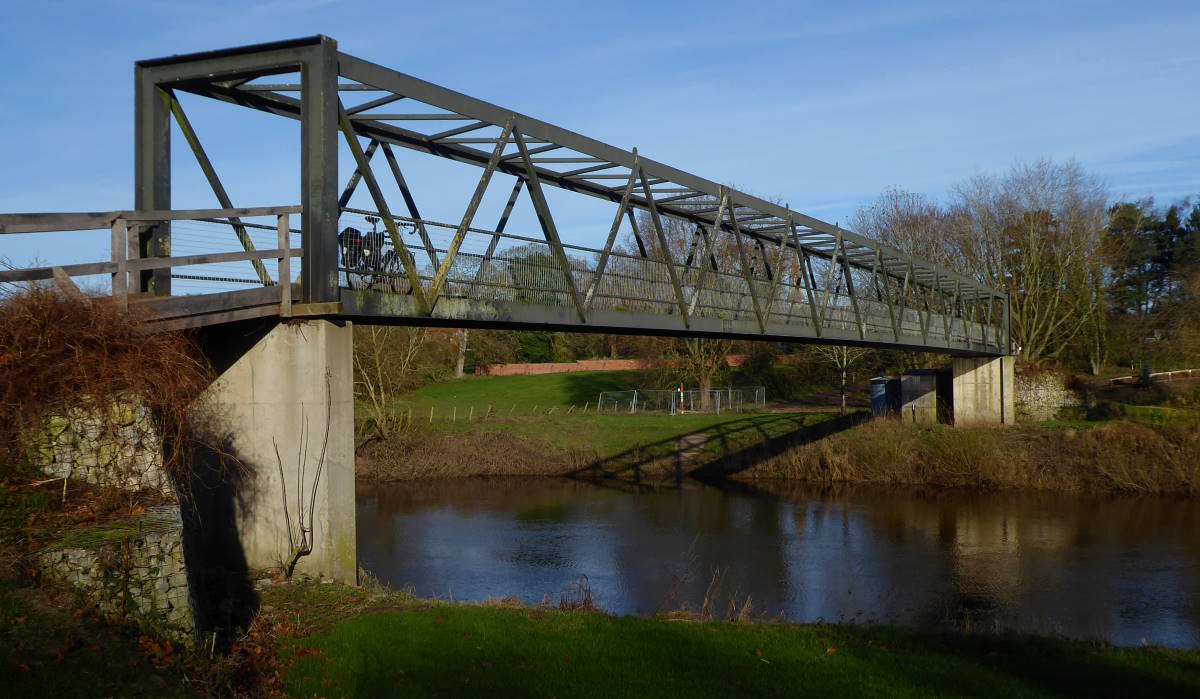A few miles upstream from York, the River Ure shiftily changes name to become the River Ouse. Why? Where? How? Who? I cycled along both rivers today to find out.

The official cut-and-paste story is that the Ure becomes the Ouse at Cuddy Shaw Reach, just before Linton-on-Ouse. For reasons never explained, the hundred-metre-wide Ure decides to take its name from a one-metre-wide stream called Ouse Gill Beck. Like, yeah. Just as elderly male billionaires are always so willing to take the surname of the teenage model who’s just married them, like, yeah, for their magnetic personality, and not for the fortune they stand to inherit, like, yeah.

The Ouse Gill Beck story has always seemed cobblers to me. The tale becomes distinctly more cobbled when you actually visit the place, as I did this cold, sharp but beautifully sunny morning. There’s a road and footbridge over Ouse Gill Beck just west of Aldwark Bridge; nearby information boards next to a picnic spot proclaim the stream’s historic importance as a sacred watercourse and repeat the naming myth.

It’s hard to accept, given the dribble that’s in front of you. Are there any certain examples anywhere else of a big river being named after a tiny tributary stream? It just doesn’t make sense.

It makes even less sense if you try to find the actual spot where Ouse Gill Beck actually enters the Ure/Ouse. Some muddy footpaths get close but the ‘confluence’ itself is fenced off on private land. Satellite photos show there’d be little to see there anyhow: Ouse Gill Beck feeds some ponds occupied by swans, but virtually none of that drains into the Ure/Ouse.

To me, the conclusion on the ground, which was rather muddy and boggy ground today, is clear: Ouse Gill Beck is named after the Ouse, not the other way round.
So why does the Ordnance Survey insist (on the Pathfinder maps) that this is the point where the Ure changes to the Ouse? The Stockton and Darlington Times may have the answer. Its columnist Sarah Walker, aka ‘Countryman’s Daughter’, did some research in 2021 and came up with a very plausible conclusion.
In brief, ‘Ure’ derives from a word meaning ‘fast-flowing’, and is the obvious name for the upper stretches. (In other words in Wensleydale, which confusingly takes its name from a formerly important village, not from the river.) Whereas ‘Ouse’ means ‘slow-flowing’, and applies to the slower, wider, floodier, ings-ier waters from York down to the Humber (where the Ouse meets the Trent; until 1757, when Naburn lock was opened, the Ouse was tidal up to York, which was very much an inland port).

Sarah reckons the few miles of the river north of York simply had two names, depending on who was talking and what they were doing. But when the Ordnance Survey mapmakers came along, they cleared up that nomenclatural loose end by buying the Ouse Gill Beck myth, and fixing the transition point there.
Not everyone agrees with the OS. The Canal & River Trust for instance, who presumably know their hydrology. They say the Ure becomes the Ouse at Swale Nab, the confluence of the Ure and Swale, a couple of miles north/upstream of Ouse Gill Beck.
That makes sense when you cycle there, as I did in my Yorkshire Rivers project in 2020. At Swale Nab, two big rivers of roughly equal size join to become something new-feeling, just as the Trent and Ouse team up to form the sprawling Humber downstream. (It also puts an industrial spanner in the rusty works of the Ouse Gill Beck myth.)

On the other hand, does the Ure actually become the Ouse at York itself? Because Sarah’s article also raises the question I’ve long asked: seeing the Ure valley was once called ‘Yoredale’, and that ‘York’ derives from ‘Jor-vik’ (pronounced ‘yor-’), isn’t it obvious that York is named after the Ure?
Well, no, scholars reckon, because there isn’t any written proof of that. According to them, ‘York’ comes from the Roman ‘Eboracum’ which became Old English ‘Eoforwic’, which then became ‘Jor-vik’. Hmm, right. So, not ‘Yore-vik’, which would mean ‘village on the Yore’, the river that the village happens to be right on?

I know what the internet says, but I also know common sense. It’s about time we had a minister for such things. And common sense tells me that ‘York’ is named after the Ure. I’m with Sarah on all this. And I also maintain that Ouse Gill Beck didn’t give its name to the Ouse, but the other way round.

Anyway, I had a lovely day in the chilly sunshine, riding round this mysterious landscape. Aldwark Bridge, a notable element of the Way of the Roses ride, is a wooden-plank crossing of the Ure (if you believe the OS) or the Ouse (if you believe the Canal & River people). Bikes go free but motor vehicles pay a toll, except they don’t at the moment because the bridge is closed for repairs.

Cyclists can still get over the Ure/Ouse, though, thanks to a footbridge just upstream that was evidently built for golf club members.

Now safely crossed over from west to east side of the Ure/Ouse, I stopped for lunch and a pint at the Linton Lock Inn, a little downstream from Ouse Gill Beck. The friendly pub and campsite sits right beside the lock and thundering weir; after my stop I cycled down the Sustrans path that follows the Ouse as it runs lazily and often broadly down to, and through, York.

All too literally through, at high-level times of the year, like now. Climate change and land use practice mean those annual once-a-decade floods are coming every few months now.
Perhaps it won’t be long before changing speeds and characters of the Ure/Ouse/Humber will result in another name change somewhere along the river…
